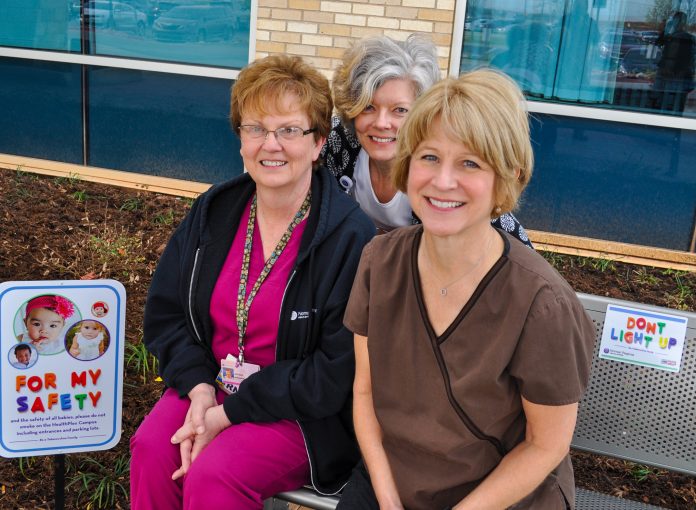
by Bobby Anderson
Staff Writer
It’s the gamut of reactions that Jerry Deming, TTS-CTS, receives when she counsels patients in the Norman Regional Health System about their tobacco use.
In her tobacco cessation role she’s been screamed at. She’s been stared at, through and around.
She’s been shunned and she’s even been hugged.
But this year she’s been able to help Norman Regional’s nurses develop a new Smoke-Free Families campaign that is gaining traction.
Deming began working with the Women’s and Children’s unit after Norman Regional nurses and managers sought help.
“There was an understanding that there were a lot of women leaving the hospital to smoke,” Deming said. “This is a very common problem. I’m in contact with people worldwide and we all deal with this problem in our hospital and clinic settings.
“We all scratch our heads and think ‘what are we going to do to handle this.’ It’s a big problem. It comes up again and again.”
Staff understood that once a mother and her baby went home then it would be easier for the patient not only to smoke, but smoke around the child.
Deming brought forward the idea that it’s a population issue and not one of monitoring.
“We needed to drill down a little bit deeper and figure out how we can help these people get through a hospital visit staying away from tobacco use and even contemplating the idea of … even quitting to have a smoke-free family.”
When leaders got together to decide a plan of action they realized they were entering uncharted landscape. Nowhere could they find a comprehensive plan dealing with the in-hospital maternity population.
Hospital stays are often so short that no one had really figured a good way to approach the issue.
Planning meetings included physicians and nurses. A craving scale – much like a pain scale – was developed.
Nurse Manager Alyson Heeke, RN, saw an opportunity.
“Part of the reason we started this in the first place is we noticed there was an awful lot of times our babies were traveling back and forth to the nursery so their parents could go outside and smoke,” Heeke said. “That became a big concern for us just in the fact they were only with us 24 to 48 hours and a good portion of the time these folks who were really addicted the babies were in the nursery sometime 20 out of 24 hours.
“We couldn’t provide what we needed for our patients if they were always outside.”
Nursing became involved in the LEAN (Lean Education Academic Network) team project helping develop educational material including posters for the room and signage for outside.
“The nurses really did want it to be a successful process for the patient as much as possible and not to be the police officer,” Heeke said. “They wanted to help them understand this also impacts how well they bond with their baby, how they do with their breastfeeding issues and all those other things which are complicated by smoking.”
Director of Patient Care Services, Susie Graves, RN, said many women who are able to quit smoking for their pregnancy often will allow themselves to resume after they deliver.
“Part of what we wanted to do was help them through. Don’t have a start date. Let that continue,” Graves said. “They all know they shouldn’t smoke … but we’re just there not as judges but as support and giving them the resources they need.”
If the patient agrees, nurses are assessing each patient every shift regarding their tobacco usage and craving level.
“(Before) nurses felt pretty helpless,” Heeke said. “Their patients would come from a C-section and be begging for a wheelchair the second the baby was born to go outside and have a cigarette.
“At this stage, with all the things we’ve created it’s given our nurses an opportunity to have something to say to the patient beyond ‘don’t you think it would be a good idea to quit.’”
Deming travels through the halls of both Norman Regional hospital complexes visiting with patients who have indicated a history of tobacco use.
For nine years now she has worked with smokers. Some are just thinking about quitting. Others are desperately looking for a way out.
And some won’t even acknowledge she’s standing in front of them.
She terms her approach as “motivational interviewing.” She stresses to her patients that she’s not there to judge.
Nearly every person Deming visits understands that they need to quit tobacco. Many have tried multiple times on their own without success.
“When we look at this population it’s the most difficult population to approach,” Deming said. “Most people smoking during their pregnancy feel ashamed of it. They don’t like to talk about it. Of course, they are very addicted to tobacco at this point because they haven’t stopped smoking. Most people know there’s going to be a health issue related to that.”
And now Norman Regional nurses have even more to offer to help these patients quit.













